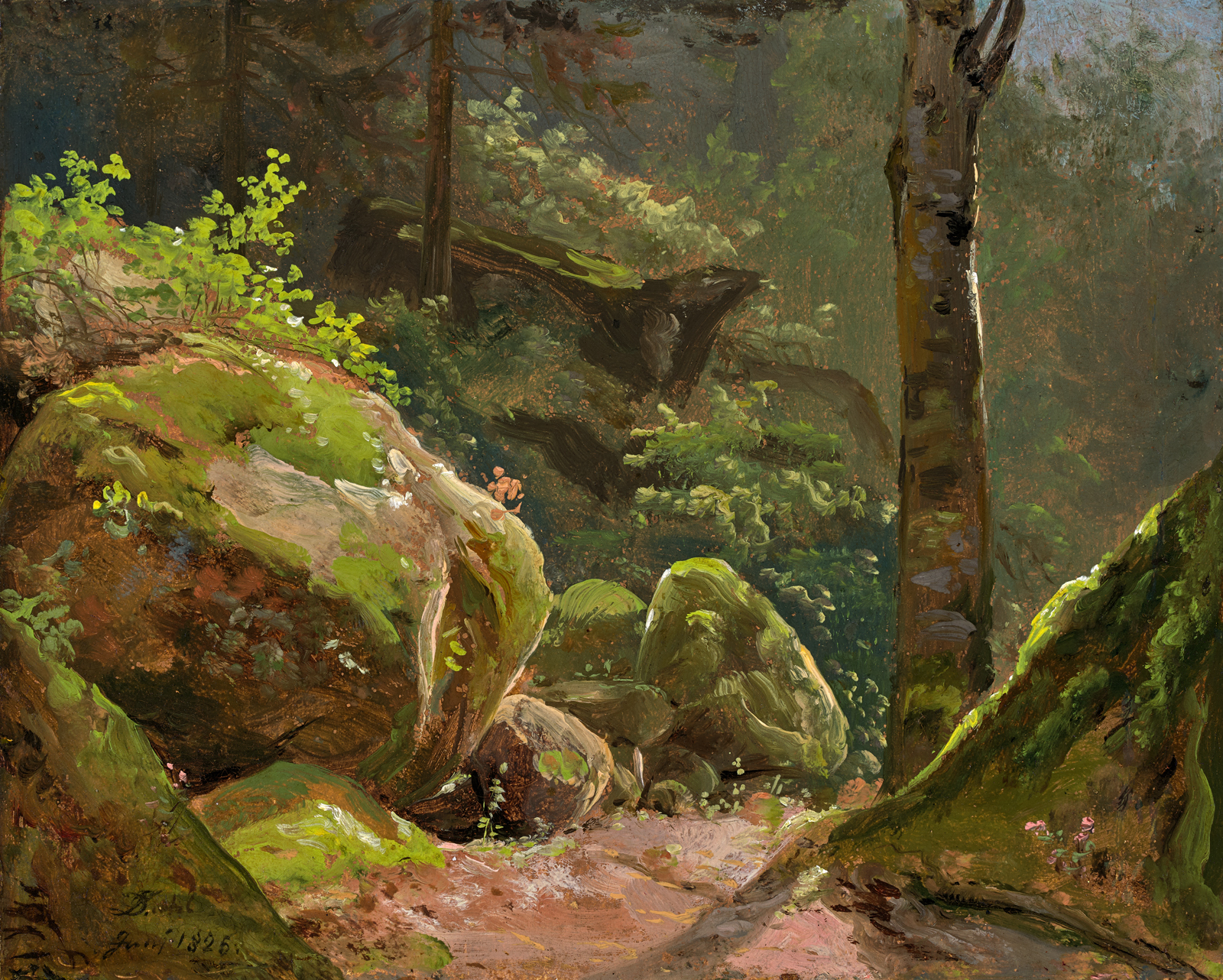Johan Christian Dahl
(Bergen 1788 - 1857 Dresden)
Boulders near Lohmen, Saxony, June 1825
Oil on paper laid down on canvas, 16 x 12 cm
Signed and dated lower left Dahl / Juni 1825
Provenance:
Attorney General John Eckhoff, Oslo[1]
Nils Onsager, Oslo[2]
Norwegian private collection
Literature:
Johan H. Langaard, J.C. Dahl's verk, Oslo 1937, no. 271
Marie Lødrup Bang, Johan Christian Dahl, 1788-1857. Life and Works, catalogue raisonné, II, Oslo 1987, no. 482
On his return from Italy in the summer of 1821, Johan Christian Dahl repeatedly turned his attention to the landscapes of Dresden, his adoptive home, to enrich his repertoire of motifs. He was attracted by subjects such as the Großer Garten, the city’s baroque park; the high, sloping banks of the river Elbe; the valley of the Plauenscher Grund; and the hilly area south-east of Dresden known as the Sächsische Schweiz. The oil studies he produced here are highly distinctive, beautifully rendered impressions of nature. They capture the topography of the region, and convey prevailing weather conditions and specific effects of light with extraordinary immediacy.
Dahl’s output of studies in the Sächsische Schweiz was large. He was attracted by dramatic rock formations like the Bastei and especially by the Plauenscher Grund, the Rabenauer Grund and the Liebethaler Grund - narrow, deeply incised valleys carved by small tributaries of the Elbe.
Dahl went on an excursion to Lohmen, a village near the Liebethaler Grund, in June 1825. In his diary entry for 13 June he noted: Have returned from Lohmen where I spent 4 days painting in the company of landscape painters Müller and von Hauch. The present work belongs to a group of five nature studies that are identically dated Juni 1825, implying that all five were almost certainly executed on the four-day excursion to Lohmen (Bang nos. 480-484, Fig. 1). [3]

Fig. 1 Johan Christian Dahl, Rock Formation near Lohmen, oil on paper laid down on cardboard, 13.4 x 15.5 cm, signed and dated lower center JD Juni 1825, formerly with Daxer & Marschall, Munich. Bang no. 483
The Liebethaler Grund is a deep, rugged gorge in the Sächsische Schweiz south-east of Dresden, where the river Wesenitz cuts through the Elbsandsteingebirge near Lohmen. In the early nineteenth century its wild scenery made it a popular destination for landscape painters. Dahl’s own exploration of the valley followed the path his friend Caspar David Friedrich had taken on sketching trips many years earlier.
I prefer to depict nature in its free, untamed condition, and to work in areas of mighty rock formations and dense forest; for that reason I am not entirely content here either [in Dresden]; while in some ways there is great beauty in nature [here], it nevertheless seems of somewhat inferior value, one finds too many traces of human hand. (Dahl in a letter to the Danish Crown Prince, Christian Frederik, dated 26 November 1818). His purpose in exploring the dramatic, untamed landscapes of the Sächsische Schweiz was almost certainly to find intact areas of nature still unshaped and uncultivated by humans.
Dahl’s handling of the conditions of light in the narrow, steep-sided valley is masterly. The sky is barely discernible – revealed only by a tiny section of grey-blue in the upper right corner of the image. Summary accents of sunlight illuminate the delicate outline of a tree trunk and model the crevices and contours of a massive boulder bordering the path. Soft browns and greens dominate the palette. Moss-covered rocks and large stones, grasses and the trailing tendrils of creepers fill the image and are set against a dense backdrop of evergreen and deciduous trees. The red petals of a tiny flower can be picked out in the lower right foreground. A recurrent motif in Dahl’s painting is the birch - The role of the birch in Dahl’s work can be compared with that of the oak in Friedrich’s paintings.[4]
In the summer of 1818, after completing his studies at the Academy of Fine Arts in Copenhagen, Dahl set out on a Grand Tour. That autumn, one of his stops was Dresden where he met and befriended Caspar David Friedrich. In summer 1820 he travelled on to Italy, returning in 1821 to settle permanently in Dresden. From 1823 onwards, he shared a house with Friedrich overlooking the river Elbe.[5]
[1] In Norwegian: Overettssakfører (abbreviated to O.r.sakf.). This was the older judicial title of an attorney who had the right to bring proceedings both before the Court of First Instance and the Court of Appeal. John Eckhoff was born on 20 February 1881 in Oslo.
[2] Nils Onsager (1874-1953), Norwegian attorney and naturalist, author of two travel books and numerous articles on walking tours, many of which were published in the yearbooks of the Norwegian tourist board. See <https://nbl.snl.no/Nils_Onsager> (accessed 13.12.2017). Onsager owned a number of paintings by Dahl. See Marie Lødrup Bang, Johan Christian Dahl 1788-1857. Life and Works, II, Oslo 1987, p. 396.
[3] Before access to Dahl’s diary earlier art historians associated the studies with the Rabenauer Grund, situated to the west of Dresden.
[4] Dahl und Friedrich. Romantische Landschaften, exhib. cat., Staatliche Kunstsammlungen Dresden and Oslo, Nasjonalmuseet for kunst, architektur og design, Oslo and Dresden 2014,
p. 111.
[5] Hans-Joachim Neidhardt, ‛Johan Christian Dahl – ein norwegischer Maler in Dresden’, in Johan Christian Dahl 1788-1857. Ein Malerfreund Caspar David Friedrich, exhib. cat., Munich, Neue Pinakothek, Munich 1988, pp. 15-19.

